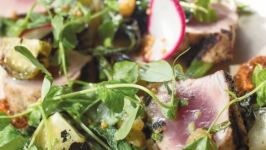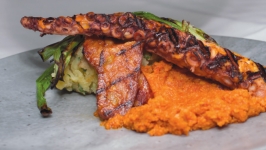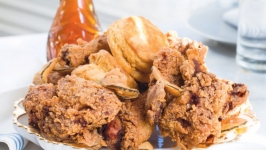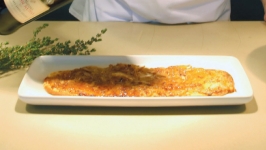Grilled Tuna with Charred Escarole & Tomatillos, Pickled Raisins & Salsa Macha
CHEF: PATRICK LACEY
RESTAURANT: TWO SEVENS
LOCATION: PRINCETON
If you want to make Patrick Lacey cringe, describe his food as fusion. “Don’t say fusion,” says the executive chef at Two Sevens in Princeton. “It is definitely not fusion.”
Latin-inspired is his preferred term, which the restaurant’s website defines as “the flavors of Central and South America, with inspiration from Chile, El Salvador, Mexico, Colombia and Peru.” Lacey’s Grilled Tuna with Charred Escarole, Tomatillos, Pickled Raisins and Salsa Macha is a tasty example of how a chef, whose culinary training focused on French and Italian cuisine, tackles the challenge of honoring, but not mimicking, the foods of Latin America.
The centerpiece of this dish is grilled yellowfin tuna seasoned with salt that is infused with furikake—a Japanese seasoning blend of dried fish, seaweed and sesame seeds. “Furikake adds a nice kind of ocean essence to the outside of the fish,” Lacey says. “Nice quality aromatics. And it helps it caramelize, too, on the grill.”
After searing on all four sides, each piece of tuna is cut into four or five rectangular slices. Those slices are arranged on individual plates atop a thin layer of salsa macha, a blend of oil, vinegar, toasted chiles, oregano, garlic and sunflower seeds, which Lacey describes as sweet, spicy, bitter, herbaceous and nutty.
To balance out the salsa’s heat, he adds charred escarole and tomatillos. “The escarole and tomatillos add a little bit of crunch and freshness. And the acidity of the tomatillos helps to balance out the spiciness of the salsa,” Lacey says. “You get some nice little bit of burnt, but sweet-and-sour happening as well. It is a balance of textures and flavors.” The charred vegetables are brightened with a squeeze of lime just before serving.
Lacey and his team rely on lime and salt to bring out the flavor in many of their dishes—a trick that he says will also benefit home cooks. “A lot of times it is just acidity and salt, and people don’t understand or realize that. It’s simple, but I don’t think a home cook has been trained to season their food generously with salt,” Lacey says. “In order to make flavor really shine through, you need that salt to enhance those flavors and then the acidity to really make them pop.” To bring in a little more balance and another hit of sweet and sour, he tops the tuna and vegetables with a scattering of pickled raisins.
When creating this dish, Lacey drew on influences and ingredients that extended far beyond Latin America. In both texture and sweet-sour flavor, the pickled raisin–charred escarole/tomatillo combination is reminiscent of caponata, a classic Sicilian dish that pairs beautifully with grilled tuna. Salsa macha, which hails from the Mexican coastal state of Veracruz, is a traditional condiment. Furikake, on the other hand, is most definitely not.
“That’s a creative input, if you will. It’s just using seaweed in a way that is fun,” Lacey says. “If you think of any coastal cuisine, you’re going to find seaweed. You also find a lot of sesame in Mexican cuisine. So, I don’t think it’s that crazy to add those two flavors to seasoning the fish.”
“Part of the fun of being a chef is that there’s always more to learn,” Lacey continues. “There is a world of food out there to discover and learn and grow. All you have is your prior experience to build on. So, you take that and apply it to something new. That’s how you can keep it different and creative.”
TWO SEVENS
277 Witherspoon St.
Princeton
609. 921.2779
twosevensrestaurant.com










